Plants and animals
A living river means many things. An important part of our mission is to create a river catchment that is packed with life and healthy ecosystems, where plants and animals can flourish in the water and surrounding environments.
Our five Parramatta River Mascots are species that live and rely on the river. Chosen by our community, they are core to our ecological health research studies as their ability to thrive is used as an indicator of water quality and catchment health.
The Mascots inhabit different types of ecological environments around the Parramatta River:
- Estuarine – the Parramatta River is tidal up to the Charles St Weir at Parramatta, and the salinity changes along the length of the river with the changing tides, the amount of fresh water flowing downstream and the weather.
- Terrestrial – the land areas in the catchment, including forests and woodlands around the river.
- Riparian – the riparian zone is the transition zone from terrestrial to river (either estuarine or freshwater), and includes saltmarshes, wetlands, mudflats, mangroves and creek beds.
- Freshwater – the tidal impact is blocked by the weirs, and upstream the Parramatta River is now fresh water.
By maintaining and improving habitats for our iconic species, especially our five Mascots, we can bring nature back to the river. Doing so means understanding current habitat health, establishing foreshore improvement programs and calling on citizen science to help track progress.
Our Riverkeeper Program participates in many projects and events that support habitat health. Learn more.
Read our Parramatta River Catchment Ecological Health Project Report.
Our Mascots
Bar-tailed Godwit
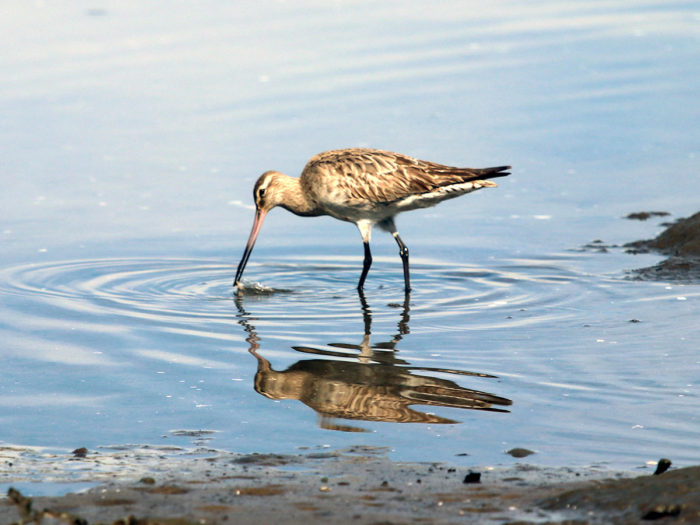 The Bar-tailed Godwit (Limosa lapponicais) is a migratory shore species that undertakes the longest non-stop flight of any bird. From its breeding grounds in the Arctic to its non-breeding grounds in the southern hemisphere, this species covers more than 11,000 km in only eight days, flying at an average speed of 50km/h. During the journey it will lose almost half its body weight.
The Bar-tailed Godwit (Limosa lapponicais) is a migratory shore species that undertakes the longest non-stop flight of any bird. From its breeding grounds in the Arctic to its non-breeding grounds in the southern hemisphere, this species covers more than 11,000 km in only eight days, flying at an average speed of 50km/h. During the journey it will lose almost half its body weight.
In the Parramatta River catchment and other parts of NSW, birds arrive between August and October and leave between February and April, with a small number remaining behind over the winter months.
A medium to large wader, the Bar-tailed Godwit is usually 37-39 cm in length (with females being bigger than males) and has a wingspan of approximately 62-75 cm. The body is mainly mottled brown above and a lighter and more uniform buff below. The species is known for its distinctive upturned bill.
The Godwit is most commonly found in coastal habitats such as sandflats, mudflats, estuaries, lagoons, lakes and bays. Adults prefer to roost on sandy beaches, sandbars and near saltmarshes, but also move to shelter inland to avoid harsh weather events.
Birds socialise in groups of up to 30 or more. Their call includes a rapid ‘tititi’ and a sharp ‘kuwit’ in alarm. Described as mostly carnivorous, they feed on insects, molluscs, crustaceans, worms, tadpoles, fish and some fruit and vegetation. Godwits feed mainly during sunlight hours, along the edge of waterways or in the shallows of sandflats and mudflats at low tide, but have also been observed to feed under moonlight.
Adults breed during their summer migration period in Scandinavia, northern Asia and Alaska. The nest is a shallow cup in moss, which can either be unlined or lined with vegetation. Two to five eggs are usually laid, which incubate for 20-21 days, and have a nestling period of 28 days. Both sexes share incubation of the eggs and care for the young.
In the Parramatta River catchment, Bar-tailed Godwits are mostly found in the Sydney Olympic Park and Homebush Bay area, Rodd Point and along the foreshore between Five Dock and Abbotsford. These habitats play a vital role in the Godwits’ survival, allowing them to roost and forage in preparation for the long migration back to their Northern Hemisphere breeding grounds.
Estuarine and coastal ecosystems such as mudflats, mangroves and seagrass beds provide structure and function for water purification, biodiversity maintenance, erosion control, carbon sequestration, and climate regulation. An abundance of foreshore birds like the Bar-tailed Godwit demonstrates we are protecting these habitats from the impact of urbanisation, pollution, weeds, erosion and reclamation.
The Bar-tailed Godwit is threatened in a number of ways:
- The presence of microplastics and other pollutants in the water and mudflats can reduce their ability to obtain the necessary energy stores required to make the return flight to breeding grounds.
- Disturbance from human activity such as fishing, power boating and other loud watercraft), dog walking (especially dogs that are not restrained), and night lighting.
- Habitat loss through land clearing, inundation, infilling or draining.
- Degradation of sediment banks and mudflats through the invasion of weeds such as cordgrass.
Learn more about the Bar-tailed Godwit.
Find out how you can help protect the Bar-tailed Godwit.
Find out about City of Canada Bay’s ‘Protecting Bar-tailed Godwits’ exhibition on now!
Eastern Long-necked Turtle
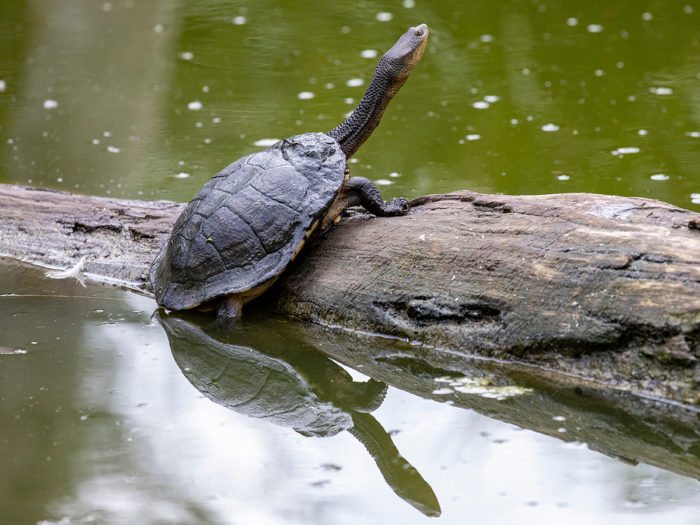 The Eastern Long-necked Turtle (Chelodina longicollis) or snake-necked turtle is commonly found across large parts of North and South Eastern Australia.
The Eastern Long-necked Turtle (Chelodina longicollis) or snake-necked turtle is commonly found across large parts of North and South Eastern Australia.
This species’ shell grows to around 25cm in length with a neck that is almost as long as its body. Known as a ‘carapace,’ the shell can vary from light to dark brown. The lower part of the shell (plastron) features yellow markings with distinctive black outlines.
Armed with very strong webbed feet and jaws, the turtles also have defensive scent glands above each leg that can squirt a liquid with a distinct, unpleasant odour when threatened.
Eastern Long-necked Turtles inhabit bodies of slow moving water like farm dams, rivers and lakes as well as soft sandy areas with logs or rocks where they can bask. They are also quite resilient, thanks to their unusual immune system, allowing them to survive in places such as polluted creeks and even sewage treatment plants.
The turtles hibernate during winter and move about the landscape in search of food in mid to late spring in preparation for the breeding season, which occurs predominantly in November and December.
Female turtles can often travel up to 200m from water to nest, but most remain close to water. Adults can produce up to three clutches of between nine and 23 eggs in a season, which take two to three months to hatch.
A carnivorous species, the turtle’s diet consists of fish, tadpoles, frogs, crayfish and insects ‒ using its webbed feet and jaws to tear apart large food items.
The Eastern Long-necked Turtle is commonly found across the Parramatta River catchment with numerous records located in and around Sydney Olympic Park. The presence of turtles in the area indicates that we are improving our wetland areas and riparian zones.
The Eastern Long-necked Turtle is threatened in a number of ways:
- Predation, especially nest predation from introduced species including cats, foxes and pigs.
- Road mortality through habitat fragmentation during migration between waterways.
- Competition for food and habitat from introduced turtles (especially in Sydney).
- Land clearing and other habitat modification.
- Water pollution events.
- Blue-green algae blooms.
- Wetland habitat loss from drought.
Learn more about the Eastern Long-necked Turtle.
Support the conservation of Australia’s turtles through TurtleSAT.
Powerful Owl
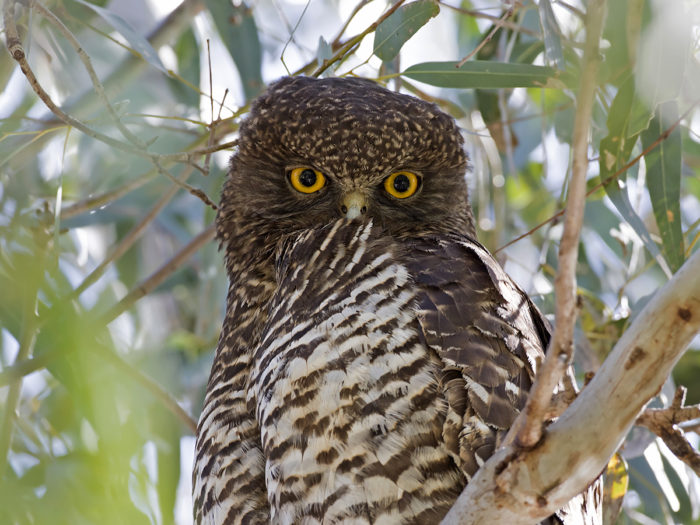 The Powerful Owl (Ninox strenua) is the largest owl in Australasia which is commonly found in eastern and south eastern parts of Australia. This species can grow up to 60cm in length with a wingspan of 140cm. It has a relatively small head and a rounded tail, and large yellow/orange feet that are equipped with sharp talons. The upper parts of the body are greyish-brown with indistinct off-white bars, and the underparts are whitish with dark greyish-brown V-shaped markings. It is known for its distinctive yellow eyes that are set in a dark grey/brown facial mask. The sexes are similar but the female is smaller with a narrower head.
The Powerful Owl (Ninox strenua) is the largest owl in Australasia which is commonly found in eastern and south eastern parts of Australia. This species can grow up to 60cm in length with a wingspan of 140cm. It has a relatively small head and a rounded tail, and large yellow/orange feet that are equipped with sharp talons. The upper parts of the body are greyish-brown with indistinct off-white bars, and the underparts are whitish with dark greyish-brown V-shaped markings. It is known for its distinctive yellow eyes that are set in a dark grey/brown facial mask. The sexes are similar but the female is smaller with a narrower head.
Powerful Owls can be heard at any time of the year, but are more vocal during the autumn breeding season. Their call is slow and deep with a resonant double hoot. Females are higher pitched with an upward inflection on the second note.
Powerful Owls usually inhabit tree hollows in a range of habitats from temperate rainforest, open tall wet forests and eucalypt forests, to woodland and sclerophyll forests (a type of vegetation that is adapted to long periods of dryness and heat).
As an apex predator, Powerful Owls are skilled hunters with prey that varies depending on their habitat. They predominantly feed on medium-sized arboreal (tree dwelling) marsupials, particularly the Common Ringtail Possum and Sugar and Greater Glider. Other prey such as flying foxes, rats, birds and even domestic cats have been documented as food sources.
Breeding and hunting usually occurs in open or closed sclerophyll forests or woodlands, with occasional hunting in open habitats. The Powerful Owl usually roosts by day in trees with thick canopies such as Turpentine, She-oak, Blackwood, Rough-barked Apple and several Eucalypt species.
While there are occasionally sightings of Powerful Owls throughout the Parramatta River catchment, most records indicate that they inhabit the north-west section where suitable forested habitat remains.
Forests and woodlands help the formation of native vegetation corridors. These corridors act as filters that cleanse the water before it enters our creeks and rivers. They can also stabilise creek banks and limit erosion and sedimentation, which suppresses further water quality decline. An abundance of Powerful Owls and other woodland birds demonstrates we are maintaining the benefits that native vegetation corridors provide.
The Powerful Owl is threatened in a number of ways:
- Habitat loss through land clearing, agricultural practices and urban development.
- A decline in Greater Glider populations, the main prey source of the Powerful Owl, which forces them to fly further away from their usual habitat to hunt and feed.
- Loss of large hollow bearing trees, which both the Powerful Owl and its prey sources depend on.
- High frequency hazard reduction which may affect prey availability.
- Insensitive removal of invasive weed species by land managers when restoring native habitat, such as broad scale weed tree eradication.
- Disturbance during the breeding season, especially near nesting sites, which can be detrimental to breeding success.
Learn more about the Powerful Owl.
Find out how you can help protect the Powerful Owl.
Southern Myotis
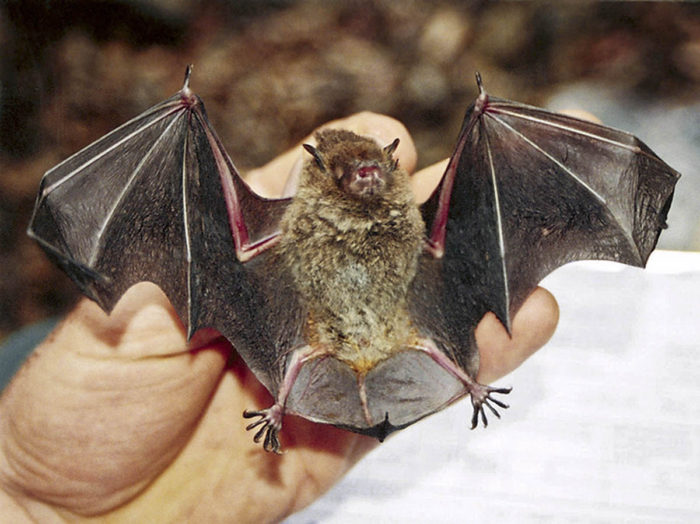 The Southern Myotis (Myotis macropus) is also known as the Large-footed Myotis. A species of vesper bat it is one of only two Australian ‘fishing’ bats that is known for its disproportionately large feet that it uses to catch its prey.
The Southern Myotis (Myotis macropus) is also known as the Large-footed Myotis. A species of vesper bat it is one of only two Australian ‘fishing’ bats that is known for its disproportionately large feet that it uses to catch its prey.
The bat’s appearance is mouse-like with small, rounded ears and dark-grey to reddish brown fur. They usually weigh up to 15 grams and have a wingspan of about 28 cm. Their feet are more than 8 mm long with widely-spaced, hairy toes and long, curved claws.
The Southern Myotis feeds on aquatic insects and small fish. They fly close to the surface of streams, reservoirs or other large bodies of water, trawling their claws to scoop up prey and bring it to their mouth, mid-flight.
This species lives in a range of habitats including caves, mine shafts, hollow-bearing trees, stormwater channels, under bridges and in dense foliage. They usually roost together in colonies of 10 to 15 and sometimes as many as 100 bats.
The female Southern Myotis breeds once a year and produces one young, usually in November or December. The gestation period is approximately 12 weeks.
Within the Parramatta River catchment the Southern Myotis is found in Sydney Olympic Park and a small number of sites in the north-west region. The presence of this species is an indication that we are maintaining riparian vegetation zones for roosting sites and improving water quality to support biodiversity for a range of prey species.
The Southern Myotis is threatened in a number of ways:
- Loss or disturbance of roosting sites and foraging areas through vegetation clearing.
- Reduction in abundance and diversity of prey species due to changes in water quality caused by vegetation clearing, sewage, pesticide and herbicide run-off.
Learn more about the Southern Myotis.
Find out how you can help protect the Southern Myotis.
Image courtesy of Brad Law.
Striped Marsh Frog
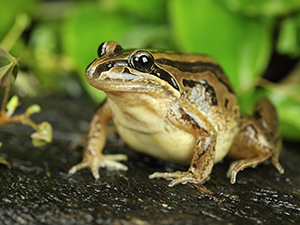 The Striped Marsh Frog (Limnodynastes peronii) is a medium to large sized frog found along the east coast of Australia from northern Queensland through to Tasmania. Known for its distinctive brown back with dark brown longitudinal stripes, this species usually reaches up to 7.5cm in length. The call is quite distinctive, described as a single ‘tuk’ or a ‘whuck’ that is repeated every few seconds.
The Striped Marsh Frog (Limnodynastes peronii) is a medium to large sized frog found along the east coast of Australia from northern Queensland through to Tasmania. Known for its distinctive brown back with dark brown longitudinal stripes, this species usually reaches up to 7.5cm in length. The call is quite distinctive, described as a single ‘tuk’ or a ‘whuck’ that is repeated every few seconds.
The Striped Marsh Frog is dependent on water, so it is usually found close to permanent ponds, lakes or streams. It feeds on a wide range of animals smaller than itself, including moths, flies, ground-dwelling insects and other frogs.
Breeding usually takes place between late spring and summer, however the frogs can also breed throughout the entire year to take advantage of rainfall in autumn and winter. Females lay up to a 1000 eggs at a time into a foam nest that floats on top of still bodies of water such as a fishpond or amongst vegetation near the edge. The tadpoles hatch after a few days, taking seven to eight months to reach maturity, and can grow up to 9.5 cm in length.
The Striped Marsh Frog is endemic across the Parramatta River catchment and has adapted well to survival in a changing urban environment. Species that thrive in clean water can be a good indication of aesthetic, recreational and often primary contact water quality. A diverse frog community tells us that the freshwater and riparian environment is healthy.
The Striped Marsh Frog is threatened in a number of ways:
- Pollution of streams, creeks and wetlands by chemicals and other runoff from the land.
- Changes to the natural flow of our waterways.
- Draining of wetlands for agriculture or urban and industrial development.
- Climate change.
Learn more about the Striped Marsh Frog.
Support the conservation of Australia’s frogs through Frog ID.

